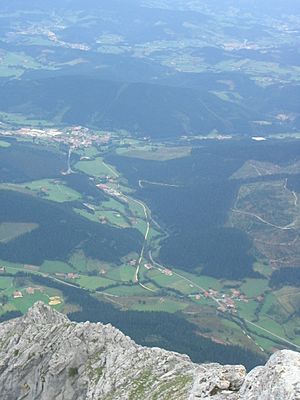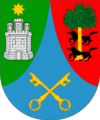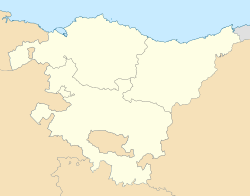Atxondo facts for kids
Quick facts for kids
Atxondo
|
||
|---|---|---|

General overview of the valley of Atxondo
|
||
|
||
| Country | ||
| Autonomous community | ||
| Province | Biscay | |
| Comarca | Durangaldea | |
| Area | ||
| • Total | 23,21 km2 (896 sq mi) | |
| Elevation | 170 m (560 ft) | |
| Population
(2018)
|
||
| • Total | 1,377 | |
| • Density | 0.5933/km2 (1.5366/sq mi) | |
| Demonym(s) | Atxondoarra | |
| Time zone | UTC+1 (CET) | |
| • Summer (DST) | UTC+2 (CEST) | |
| Postal code |
48291
|
|
Atxondo is a small town in the Basque Country, Spain. It is located in the province of Biscay. Atxondo is part of a region called Durangaldea. About 1,377 people live there as of 2018.
Atxondo was created in 1962. It was formed when three older towns, called Apatamonasterio, Arrazola, and Axpe, joined together. These towns were known as elizates. An elizate is a special type of old Basque town.
Contents
What's in a Name?
The name Atxondo comes from the Basque words (h)A(i)tz and ondo. (h)A(i)tz means "rock," and ondo means "at the side of." So, Atxondo means "at the side of the rock." The name Axpe means "under the rock."
A Look Back in Time
Before 1962, Atxondo was a valley with three separate towns. These towns were Apatamonasterio, Arrazola, and Axpe. Each of them had its own long history.
Apatamonasterio's Story
The name Apatamonasterio means "clergy monastery." It was named this way to tell it apart from another monastery. This town was involved in the War of the Bands, which were conflicts between powerful families long ago. Apatamonasterio had a say in important local meetings. For a long time, its economy was based on farming.
Arrazola's Past
Arrazola also took part in the War of the Bands. Important people were born here, like Esteban de Urizar. He was a governor in Peru a long time ago. Another person was Juan Alexandro Arrazola de Oñate. He worked for important leaders in the Spanish Netherlands. The town's church was built in 1510.
Axpe's History
Like the other two towns, Axpe was also part of the War of the Bands. It also had a voice in the local meetings. The church in Axpe was built in 1550.
Exploring the Land
Atxondo is in the southeastern part of the Biscay province. It shares borders with other towns like Abadiño and Elorrio. To the south, it borders the province of Álava. The Ibaizabal river starts here when it meets the Zumalegi river. The Zumalegi river comes from the Anboto mountain.
Atxondo has two main parts. One is an industrial area around Apatamonasterio. The other part is for farming and homes. This includes Axpe, Arrazola, and the neighborhoods of Marzana and Santiago. Atxondo is about 6 kilometers from Durango. Durango is the main town of the region. It is also about 36 kilometers from Bilbao, the capital city of the province.
Getting Around
The main way to travel in Atxondo is by road. The BI-634 road goes through the valley, passing Apatamonasterio. This road connects Durango with Arrasate-Mondragón. In Durango, you can connect to bigger roads and highways. These roads lead to cities like Bilbao and Donostia-San Sebastián.
In Arrasate-Mondragón, the BI-634 road connects to another highway. This highway goes to Eibar and then to Donostia-San Sebastián and France. It also goes to Vitoria-Gasteiz, the capital of Álava.
There are also bus lines that stop in Atxondo. These buses connect Atxondo with nearby towns and cities. For example, one line connects Apatamonasterio with Bilbao. Another line connects Durango with Arrazola.
See also
 In Spanish: Valle de Achondo para niños
In Spanish: Valle de Achondo para niños




